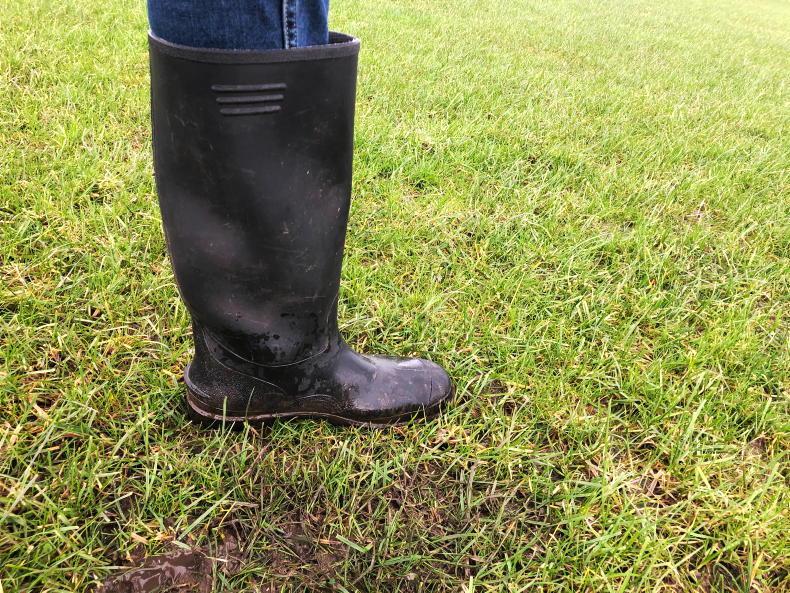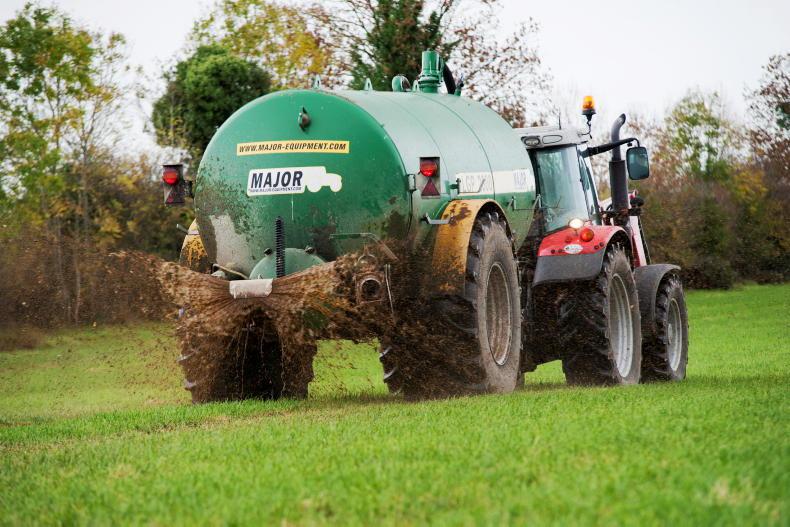The closed period for spreading slurry and fertiliser on NI farms ends this weekend and slurry tankers will become a familiar sight on fields as soon as ground conditions permit.
But before tankers start to roll, think about how you can get the best use of nutrients in slurry, farmyard manure and chemical nitrogen.
Nitrogen prices are expected to rise further this spring, so making better use of slurry will limit the amount of purchased fertiliser required to kick-start grass in the coming months.
Outlined are some tips to getting the most from early spring applications of slurry and chemical fertiliser.
The starting point for any fertiliser plan is a soil sample. If fields have not been sampled in the past five years, it is worth doing this before any slurry of chemical nitrogen is applied.
This way, the sample gives a much more accurate reflection of soil fertility levels. Once fertiliser or slurry has been applied, fertility levels will be distorted and less accurate.
Each sample size should reflect around 10ac of ground. Grouping together the smaller fields that get similar fertiliser treatments makes sampling more cost effective.
Bigger fields, or fields likely to be reseeded this year, should be sampled individually. Soil samples will give an indication of soil pH, phosphate (P) and potash (K) levels.
On grassland farms, soil pH should ideally be 6.0 to 6.5, with P and K levels around index 2 and index 3. As pH falls below 6.0, soil nutrients are locked up and cannot be accessed by plant roots.
When the P and K levels fall below index 2, soils are lacking in fertility and grass growth will be hindered.
P is important for root development and nutrient uptake, while K is important for circulating nutrients within the plant.
2 Fertiliser value of slurry
Slurry produced from cattle fed concentrates over winter will be a good source of nutrients, which can be recycled back on to grassland.
The higher the concentrate levels fed, the more potent the fertiliser. Therefore, don’t automatically assume all cattle slurry on farm will do the same job.
Slurry from dry cows will be low in nutrients and, in most cases, it will need topping up with bagged fertiliser to kick-start grass growth.
The other factor to bear in mind is that the nitrogen availability in slurry is highest with early to mid-spring applications.
Therefore, get as much slurry spread on grassland from February to April as possible, as the growth response will be higher.
3 Targeting fields with slurry
If tanks are filled to capacity, the immediate priority will be on getting slurry out on the driest fields as soon as possible.
But if storage tanks are not under the same storage pressure, the aim should be to target as much slurry as possible to the fields with the lowest P and K levels, as ground conditions permit this spring.
Silage fields should be targeted with slurry, as cutting the same sward year after year will quickly deplete fertility levels if the nutrient offtake is not being replaced.
As a rule of thumb, around 7kg of P and 24kg K is removed with every tonne of silage on a dry matter basis. This means for a silage crop averaging 10t/ac on a fresh weight basis, approximately 14 units/ac of P and 100 units/ac of K needs to be applied to balance nutrient offtake.
Walk the farm and make a note of which fields have bare or low grass covers, making them suitable for spreading slurry. Fields with low covers are unlikely to be grazed until the end of the first rotation.
Walk the farm and target slurry to the fields with the lowest grass covers.
This leaves more time to get slurry washed in to soils and avoids a potential delay to when swards can be grazed. On paddocks with a moderate grass covering (above ankle height), these swards should be grazed off before slurry is applied.

Where paddocks are carrying heavier covers, then swards should be grazed off before slurry is applied.
The alternative is to apply chemical fertiliser to kick-start grass growth. On heavier swards where the base of the plant is turning white, grazing is the best option before applying any form of fertiliser.
Grass growth is practically non-existent once soil temperatures drop below 5°C, so fertiliser applications should be avoided during cold spells.
However, once soil temperatures start to rise, nutrients should be applied at the earliest opportunity to maximise growth rates.
Keep safety in mind when working with slurry
Slurry gases can be deadly, so always keep safety in mind. When mixing the tank, the first few minutes after agitating slurry are when gases are most potent.
Sheds, or cattle pens closest to the mixing points, should be emptied of livestock before the pump is started. Slurry should only be agitated on windy days to displace the build-up of toxic gas.
In older sheds with an indoor mixing point, leave the shed as soon as the pump is turned on. Keep all children and farm pets away from sheds and always cover tank openings when left unattended.
Read more
Minimising silage losses at feed-out this winter
Newford Farm: mid-winter weighing shows positive performance
The closed period for spreading slurry and fertiliser on NI farms ends this weekend and slurry tankers will become a familiar sight on fields as soon as ground conditions permit.
But before tankers start to roll, think about how you can get the best use of nutrients in slurry, farmyard manure and chemical nitrogen.
Nitrogen prices are expected to rise further this spring, so making better use of slurry will limit the amount of purchased fertiliser required to kick-start grass in the coming months.
Outlined are some tips to getting the most from early spring applications of slurry and chemical fertiliser.
The starting point for any fertiliser plan is a soil sample. If fields have not been sampled in the past five years, it is worth doing this before any slurry of chemical nitrogen is applied.
This way, the sample gives a much more accurate reflection of soil fertility levels. Once fertiliser or slurry has been applied, fertility levels will be distorted and less accurate.
Each sample size should reflect around 10ac of ground. Grouping together the smaller fields that get similar fertiliser treatments makes sampling more cost effective.
Bigger fields, or fields likely to be reseeded this year, should be sampled individually. Soil samples will give an indication of soil pH, phosphate (P) and potash (K) levels.
On grassland farms, soil pH should ideally be 6.0 to 6.5, with P and K levels around index 2 and index 3. As pH falls below 6.0, soil nutrients are locked up and cannot be accessed by plant roots.
When the P and K levels fall below index 2, soils are lacking in fertility and grass growth will be hindered.
P is important for root development and nutrient uptake, while K is important for circulating nutrients within the plant.
2 Fertiliser value of slurry
Slurry produced from cattle fed concentrates over winter will be a good source of nutrients, which can be recycled back on to grassland.
The higher the concentrate levels fed, the more potent the fertiliser. Therefore, don’t automatically assume all cattle slurry on farm will do the same job.
Slurry from dry cows will be low in nutrients and, in most cases, it will need topping up with bagged fertiliser to kick-start grass growth.
The other factor to bear in mind is that the nitrogen availability in slurry is highest with early to mid-spring applications.
Therefore, get as much slurry spread on grassland from February to April as possible, as the growth response will be higher.
3 Targeting fields with slurry
If tanks are filled to capacity, the immediate priority will be on getting slurry out on the driest fields as soon as possible.
But if storage tanks are not under the same storage pressure, the aim should be to target as much slurry as possible to the fields with the lowest P and K levels, as ground conditions permit this spring.
Silage fields should be targeted with slurry, as cutting the same sward year after year will quickly deplete fertility levels if the nutrient offtake is not being replaced.
As a rule of thumb, around 7kg of P and 24kg K is removed with every tonne of silage on a dry matter basis. This means for a silage crop averaging 10t/ac on a fresh weight basis, approximately 14 units/ac of P and 100 units/ac of K needs to be applied to balance nutrient offtake.
Walk the farm and make a note of which fields have bare or low grass covers, making them suitable for spreading slurry. Fields with low covers are unlikely to be grazed until the end of the first rotation.
Walk the farm and target slurry to the fields with the lowest grass covers.
This leaves more time to get slurry washed in to soils and avoids a potential delay to when swards can be grazed. On paddocks with a moderate grass covering (above ankle height), these swards should be grazed off before slurry is applied.

Where paddocks are carrying heavier covers, then swards should be grazed off before slurry is applied.
The alternative is to apply chemical fertiliser to kick-start grass growth. On heavier swards where the base of the plant is turning white, grazing is the best option before applying any form of fertiliser.
Grass growth is practically non-existent once soil temperatures drop below 5°C, so fertiliser applications should be avoided during cold spells.
However, once soil temperatures start to rise, nutrients should be applied at the earliest opportunity to maximise growth rates.
Keep safety in mind when working with slurry
Slurry gases can be deadly, so always keep safety in mind. When mixing the tank, the first few minutes after agitating slurry are when gases are most potent.
Sheds, or cattle pens closest to the mixing points, should be emptied of livestock before the pump is started. Slurry should only be agitated on windy days to displace the build-up of toxic gas.
In older sheds with an indoor mixing point, leave the shed as soon as the pump is turned on. Keep all children and farm pets away from sheds and always cover tank openings when left unattended.
Read more
Minimising silage losses at feed-out this winter
Newford Farm: mid-winter weighing shows positive performance








 This is a subscriber-only article
This is a subscriber-only article










SHARING OPTIONS: